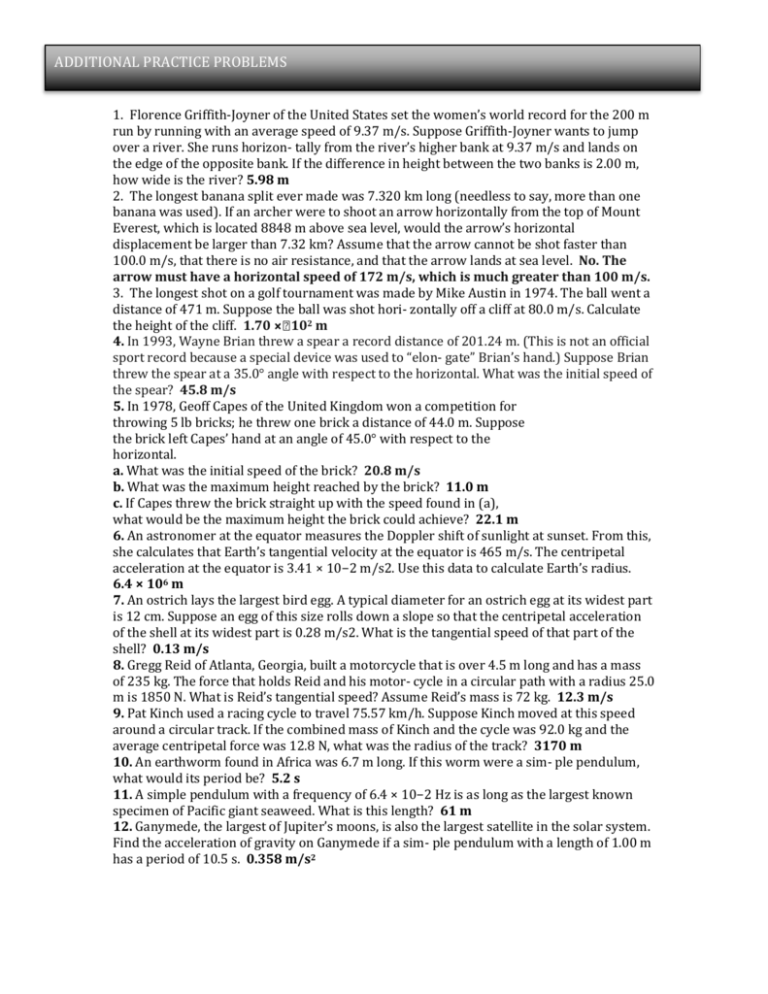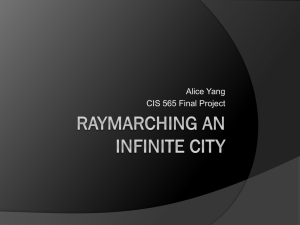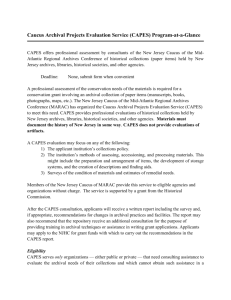Extra Practice Sheet #6-12
advertisement

ADDITIONAL PRACTICE PROBLEMS 1. Florence Griffith-Joyner of the United States set the women’s world record for the 200 m run by running with an average speed of 9.37 m/s. Suppose Griffith-Joyner wants to jump over a river. She runs horizon- tally from the river’s higher bank at 9.37 m/s and lands on the edge of the opposite bank. If the difference in height between the two banks is 2.00 m, how wide is the river? 5.98 m 2. The longest banana split ever made was 7.320 km long (needless to say, more than one banana was used). If an archer were to shoot an arrow horizontally from the top of Mount Everest, which is located 8848 m above sea level, would the arrow’s horizontal displacement be larger than 7.32 km? Assume that the arrow cannot be shot faster than 100.0 m/s, that there is no air resistance, and that the arrow lands at sea level. No. The arrow must have a horizontal speed of 172 m/s, which is much greater than 100 m/s. 3. The longest shot on a golf tournament was made by Mike Austin in 1974. The ball went a distance of 471 m. Suppose the ball was shot hori- zontally off a cliff at 80.0 m/s. Calculate the height of the cliff. 1.70 102 m 4. In 1993, Wayne Brian threw a spear a record distance of 201.24 m. (This is not an official sport record because a special device was used to “elon- gate” Brian’s hand.) Suppose Brian threw the spear at a 35.0° angle with respect to the horizontal. What was the initial speed of the spear? 45.8 m/s 5. In 1978, Geoff Capes of the United Kingdom won a competition for throwing 5 lb bricks; he threw one brick a distance of 44.0 m. Suppose the brick left Capes’ hand at an angle of 45.0° with respect to the horizontal. a. What was the initial speed of the brick? 20.8 m/s b. What was the maximum height reached by the brick? 11.0 m c. If Capes threw the brick straight up with the speed found in (a), what would be the maximum height the brick could achieve? 22.1 m 6. An astronomer at the equator measures the Doppler shift of sunlight at sunset. From this, she calculates that Earth’s tangential velocity at the equator is 465 m/s. The centripetal acceleration at the equator is 3.41 × 10−2 m/s2. Use this data to calculate Earth’s radius. 6.4 × 106 m 7. An ostrich lays the largest bird egg. A typical diameter for an ostrich egg at its widest part is 12 cm. Suppose an egg of this size rolls down a slope so that the centripetal acceleration of the shell at its widest part is 0.28 m/s2. What is the tangential speed of that part of the shell? 0.13 m/s 8. Gregg Reid of Atlanta, Georgia, built a motorcycle that is over 4.5 m long and has a mass of 235 kg. The force that holds Reid and his motor- cycle in a circular path with a radius 25.0 m is 1850 N. What is Reid’s tangential speed? Assume Reid’s mass is 72 kg. 12.3 m/s 9. Pat Kinch used a racing cycle to travel 75.57 km/h. Suppose Kinch moved at this speed around a circular track. If the combined mass of Kinch and the cycle was 92.0 kg and the average centripetal force was 12.8 N, what was the radius of the track? 3170 m 10. An earthworm found in Africa was 6.7 m long. If this worm were a sim- ple pendulum, what would its period be? 5.2 s 11. A simple pendulum with a frequency of 6.4 × 10−2 Hz is as long as the largest known specimen of Pacific giant seaweed. What is this length? 61 m 12. Ganymede, the largest of Jupiter’s moons, is also the largest satellite in the solar system. Find the acceleration of gravity on Ganymede if a sim- ple pendulum with a length of 1.00 m has a period of 10.5 s. 0.358 m/s2










